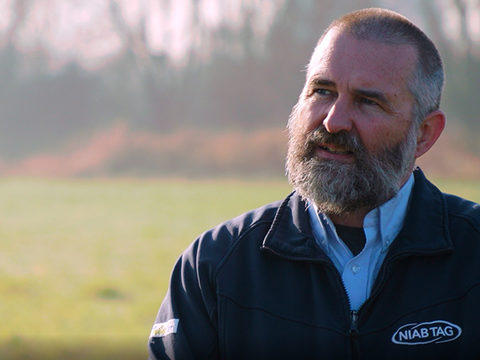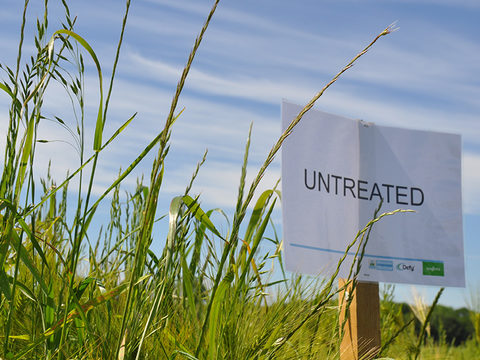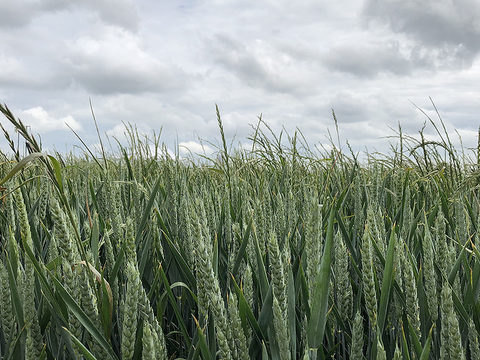Pre-harvest picture of grass weed problems

Mapping grass weed problems in fields pre-harvest can provide valuable pointers to tailor this autumn’s control strategies, advocates Syngenta Field Technical Manager, Pete Hawkins.
“Integrated control measures have an increasingly important role in managing grass weed populations to greater effect, utilising a range of cultural controls alongside the planned DEFY herbicide programme,” he advised.
“A better understanding of specific weed threats in individual situations enables the most appropriate strategy to be developed that will fit in with the practical management of fields and overall farm cropping.”
Grass weed decision making
Pete advocates pre-harvest assessment and recording of grass weed populations during June will capture data to make better informed decisions as the seasons progress.

Once the combine has been through, it’s easy to forget just where and to what extent weed populations had occurred. Digital mapping is becoming widely available and increasingly sophisticated to record not just the presence of weed numbers, but also the level of infestation.
For some growers a simple traffic light system of red, amber or green colour depicting the level of weed infestation and problem weeds can suffice to adapt management strategies. Red or amber risk fields can be stacked with focus on more cultural controls and a more robust DEFY herbicide strategy, while clean green fields could suffice with a lighter touch approach.
Cover crop options
Options to use cover crops and environmental habitat creation, along with their associated payments, as planned parts of the crop rotation to reduce grass weed burdens, or livestock integration in regenerative systems, rely on focusing on the worst affected areas to get the greatest results.
The earlier in the season the potential grass weed threat has been identified could help influence the cropping choices in the rotation, he suggests.
For autumn sowing, heavily infested fields are likely to benefit more from growing a highly competitive hybrid barley, compared to wheat or conventional 2-row or 6-row barley, to further help reduce the impact of grass weeds, for example.

Syngenta ryegrass trials in a high weed burden situation have shown hybrid barley reduced the number of seed heads in the crop by over 50%, compared to conventional barley. The Yorkshire trials also showed a 65% reduction in seed heads compared to winter wheat, from 328 heads per m2 to 114.
Delayed drilling dates
Pre-harvest assessment of weed burden could also influence cultivations or establishment options for individual fields, and most importantly the drilling date, he advises. “Syngenta trials have repeatedly shown that delayed drilling, to enable more grass weed seedlings to be targeted in the seedbed prior to planting, can have the greatest impact of all the cultural controls."

“However, the longer the delay the greater the inherent risk of adverse weather impacting on crop establishment – and ultimately missing the season. How late you can leave drilling will be dictated by individual farm situations, and the growers’ own attitude to risk.”
In mixed weed populations recording the prevalence of different weed species will also have an implication for autumn control strategies, as well as year-on-year identifying any shifts that require a response in agronomy approaches.
For wild oats, identification and recording whether populations are the winter wild oat or common spring wild oat would have implications for subsequent germination patterns and management strategies, suggested Pete. The two different species are quite difficult to differentiate during the vegetative growing state, but relatively easy to tell apart when seed heads are formed and the number of awns on the seed visible.

“Although the germination patterns between the two species are not completely distinct, there is a trend for the more common wild oat to emerge in the autumn, and the spring wild oat later in the growing season.
“Syngenta research with NIAB indicates that knowing the population present could help adapt crop establishment timing and herbicide focus for DEFY in the autumn and AXIAL PRO timing the following spring to best target grass weed emergence timing.”
Herbicide trials
Results from multiple grass weed trials have shown that stacking three different active ingredients in a pre-em application increased overall control by an average 8%, compared to using just two actives. Adding four ai’s in the mix increased control by a further 9% compared to three.
Furthermore, the trials have shown that while adding DEFY at 2.0 l/ha increased control of a flufenacet + diflufenican base pre-em by 10%, increasing the DEFY rate to 4.0 l/ha gave a 21% increase in the control of target grass weeds. In ryegrass trials, DEFY at 4.0 to 5.0 l/ha added more than 20% to pre-em herbicide efficacy, compared to FFT/DFF alone.
Pete also pointed out that recording of black-grass populations pre-harvest can also be coupled with weather records at the time of the grass weed flowering – which research suggests is correlated to seeds’ autumn germination. Cool wet weather through mid-June is typically linked to slower autumn germination levels, while hot, dry weather through the same period tends to result in faster weed emergence.
“The implication is that in rapid germination seasons more black-grass will chit and can be eliminated in the stale seedbed, compared to a higher proportion of later emerging weeds in a longer dormancy season that could be more competitive with the growing crop.
“While weed germination timing is outside of the grower’s control, knowing the effects in a specific season may influence decisions on drilling date and the priority for loading of pre-emergence DEFY herbicide strategies, or potential for post-emergence treatments to extend residual activity, for example.”

Syngenta grass weed trials have shown that in a low dormancy year (2018/19) loading more into a pre-emergence application and including higher rates of DEFY increased overall control by 22% over a base pre-em strategy, while in a high dormancy year (2016/17) a shift to more of a sequence of autumn herbicides gave a 27% increase in control over the pre-em application alone.
“The challenge of planning for a sequenced approach is always the risk that weather conditions may compromise later applications,” warned Pete.
“Particularly if drilling has been delayed to allow more of the later germinating grass weeds to chit, when there is a higher chance of autumn weather breaking.”
Herbicide resistance management
Mapping is also an essential tool for potential herbicide resistance management. “Knowing where controls have failed or had limited effect is essential not to take the same approach again, when results could be expected to quickly diminish if resistance has occurred,” warned Pete. Tracking of resistance through testing needs to be accurately recorded, to pick out and rapidly respond to problems.

With more precise mapping of weed populations, growers could look to just move the soil surface in selected areas of the field to encourage weed chit – reducing costs and with lower overall surface disturbance, for example.
Furthermore, with new technology increasingly linking direct to machinery operation, there is already an opportunity to raise seed rates in more grass weed infested areas to increase the crop competition.
Starting this route of adaptive agronomy utilising artificial intelligence will prepare for a future where more inputs can be adjusted on the move, to initially enhance the crop efficiency, but also with the potential to better target specific grass weed populations. It raises the potential for prescriptive patch spraying, or even individual plant spot spraying when populations can be managed down to low enough numbers.
Adaptive agronomy
Even before we reach that stage, growers and agronomists now can adapt herbicide strategies that can effectively target known levels of grass weed populations, at a field-by-field level or even down to areas within the field.
Within the parameters of physical application capability and permitted product label rates, it is possible with today’s sprayer technology to increase rates by 20 or 25% on a particularly badly affected headland or grass weed affected area, compared to the intended standard field rate, for example.

NIAB trials, in association with Syngenta, have this season been assessing combinations of control options including hybrid barley, compared to conventional barley or wheat, along with varying the intensity of herbicide programmes, on both an early and a late drilled crop. The trials have been repeated on a heavily infested black-grass and ryegrass site.
In-field monitoring of the trials through the season has already highlighted the immense potential of the hybrid barley to reduce both the numbers and particularly the vigour of any grass weeds, compared to conventional wheat or barley. Previous years of research has shown that this has an impact on reduced crop effect and significantly lower viable seed return from the grass weed plants.
Increased control
Allied to that, the research has shown, not surprisingly, the increased grass weed control achieved in both black-grass and ryegrass with more robust herbicide programmes, including increasing the rate of DEFY from 2.0 l/ha in a lower input scenario to 5.0 l/ha in a full programme. That confirms years of trials showing a step increase in overall control levels from increased rates of DEFY in any herbicide mixture.
Where this work will be of greatest value is providing advice and guidance to growers and agronomists in selecting the most appropriate level of herbicide input in the scenarios of different drilling date and cropping choices against varying weed pressures and species.
However, it’s full value can only be exploited where grass weed populations have been identified in the field and monitored over successive seasons to evaluate which options to best employ and where they will gain best effect.
Building up a pre-harvest picture of grass weed populations now will start to map out a route for better grass weed control strategies in the future.












